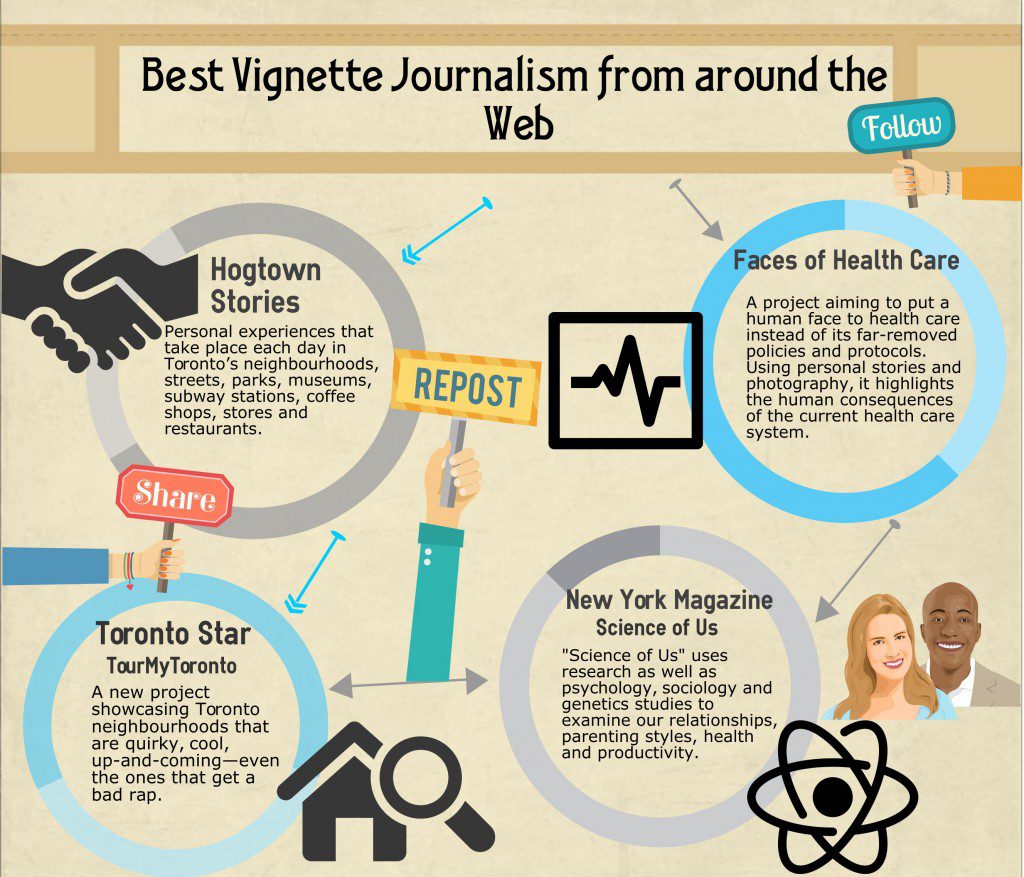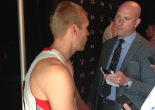Vignette Journalism: Storytelling for the Social Media Age
How news outlets engage readers and audiences with tales of unsung people doing extraordinary things
I sat in a heart surgeon’s office, waiting to ask what it’s like to touch a beating heart. It’s not every day that you get to put such questions to people, even as a journalist. But this summer at the Calgary Herald, my editor assigned me to a project called What’s it Like? The idea was to ask local people about unique experiences. I also spoke to a former astronaut, a meteorite tracker, a paramedic and a paleontologist. I mostly presented the stories from the perspective of the subjects, as though they were talking directly to the reader. This approach erased me, the journalist, as the messenger.
The goal of our series, according to Tony Seskus, the Herald’s senior editor of news and my supervisor, was to find stories that reporters rarely tell. They’re about “people who are everyday, maybe unsung people, who do some pretty extraordinary, amazing things,” he says. We are surrounded by neighbours with stories to share, yet we never ask to hear them. These vignettes are meant to start that conversation. They’re “friendly,” as though you’re telling someone over a drink about something notable you did that day, except it’s an interesting person engaging with the reader at home.
Such series help readers get to know their neighbours at a time when, for many of us, connections over social media are more common than face-to-face encounters. It has become normal to know someone you’ve never met, who may live anywhere in the world and have a life that’s completely different from yours. You may be keeping up with Kim Kardashian West’s every move, but here’s someone who lives around the corner and has an interesting life. Although vignette journalism doesn’t tell the full story, it helps us understand the communities we live in. We can get our long features and our traditional human interest stories anywhere, but now some news outlets are engaging readers and audiences by putting more emphasis on this style of storytelling in the age of social media.
When I started working on the Herald series, it reminded me of Vice stories with headlines that start, “We talked to the guy who…” and Brandon Stanton’s wildly popular Humans of New York, a series of photographs accompanied by short captions, usually a quotation. Stanton has even gone global on sponsored tours, most recently to photograph refugees in Eastern Europe. Another example is The Globe and Mail’s What It’s Like health series, which health editor Hayley Mick says was partly inspired by Humans of New York. Reporter Wency Leung writes the majority of these stories from the perspective of the subject—with some even written by the subjects themselves—to build a sense of connection between the subject and the reader, which fosters empathy. This is especially true for health stories, where part of the aim is to help the audience understand what it’s like to have a certain medical condition.
Vignette stories connect well with online audiences because of their conversational tone, says Alfred Hermida, author of Tell Everyone: Why We Share and Why It Matters and director of the graduate school of journalism at the University of British Columbia. Social media is about making connections between people, so the impartial voice of a news article doesn’t play well. “You don’t want the voice of God through social media,” he says. “You want a person talking to you.” Longer human interest stories, meanwhile, usually have a mix of people telling their stories and disinterested voices from experts or information from documents.
When I asked Hermida if vignettes are the modern evolution of human interest stories, he pointed out that they aren’t necessarily anything new. Broadcast journalists have long used one person as an example of a larger story, as have print journalists with their anecdotal leads. But what’s different these days is the time and emphasis given to these vignettes, says Hermida. “It’s seen as more a central part of what the organization should be doing: reflecting the community back to itself.”
There are still challenges with this type of writing, including the problem of trying to fully reflect a community with only a few people’s stories. When we were putting our series together, it was hard to go beyond the usual suspects and find “unsung” people who had done interesting things. This is also the most challenging part for Leung, who says, “It’s not like there’s a phone book of people that you can look up people who have an allergy to cold.”
I also found that we ended up speaking to a lot of men for our series. I’m sure there were many reasons for that, including the common view that men are more comfortable sharing their achievements. But it still meant that we didn’t have the most balanced reflection of the community that we could have. CBC Vancouver did a Faces of BC project, with the goal of including a resident from every country in the world, but it depended on people submitting photos and captions. The station didn’t quite get every country, although it did reach an impressive 147 out of 194.
The Faces of BC project highlights one of the benefits of vignette journalism—it can increase an audience while encouraging participation. Seskus hopes that the Herald series, which started rolling out in early October, will help the paper engage with the community in new ways. He wants readers to submit other interesting experiences.
These stories move people to engage because they’re powerful. Mick says that power can come from how direct and personal they are: “Sometimes in 300 words, you can move people more than you can with a whole bunch of experts and a whole bunch of stats.”
Erin Sylvester is the head of research for the Spring 2016 issue of the Ryerson Review of Journalism. Her work has appeared in several publications, including the Calgary Herald and the Torontoist.
















































